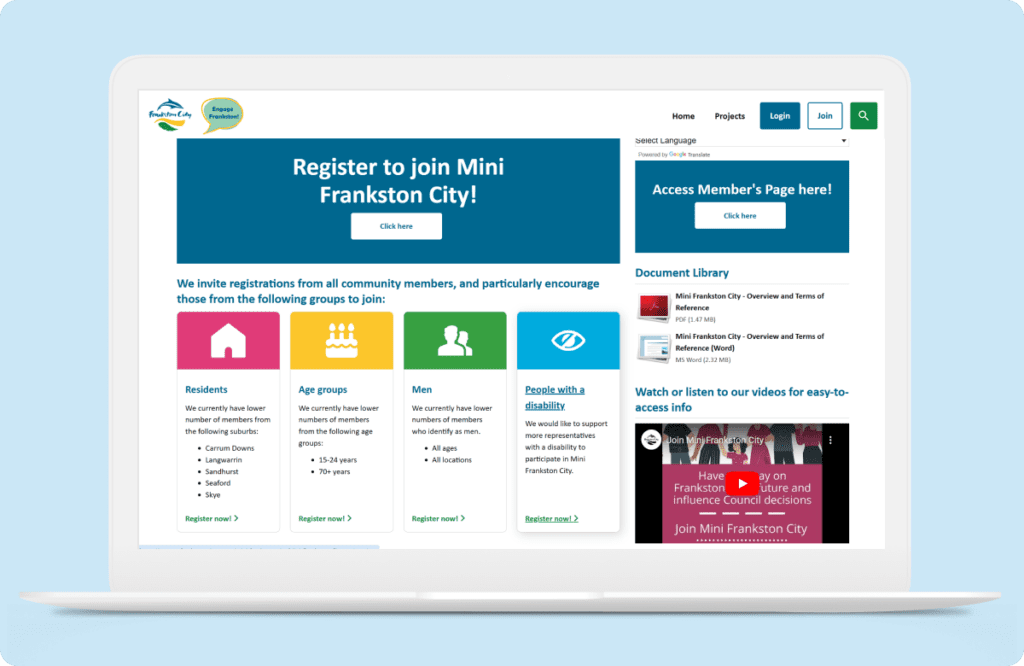At the start of each year, we dive into emerging trends in online community engagement, making predictions about what the next 12 months might bring. Now that 2024 is drawing to a close, it’s time to revisit those predictions and reflect on how they’ve panned out. By engaging with a broad range of clients, potential customers, and professionals across sectors—from local and state governments to industries and not-for-profits—we gain valuable insights into how community engagement is evolving and influencing decision-making processes.
Social Pinpoint’s close ties to the “frontline” help us spot trends early and anticipate shifts. Let’s take a closer look at how our top predictions for 2024 played out.
Here were our top five online community engagement predictions for 2024:
- Hyperlocal Engagement
- Elevated Data Transparency
- AI Adoption at the Organisation Level
- Community Empowerment in (Private) Digital Workspaces
- Low Barrier Engagement
1. Hyperlocal Engagement
As mentioned in our 2024 community engagement trends blog, communities are becoming more familiar with public engagement. Since COVID, they have become increasingly hyperlocal in their thinking and acting.
In 2024, we predicted that organisations would need to adapt by offering tailored information and conducting consultations to better engage specific communities on hyperlocal projects.
While we don’t think we’ve seen the biggest shift yet to hyperlocal consultations (e.g., at a street level), we have noticed a growing trend, particularly within local government in Australia. These organisations aim to help communities gain a clearer understanding of what is happening in their local areas while encouraging residents to participate in engagement activities to foster trust—giving people the chance to raise issues or questions with their local ‘neighbourhood officer.’
By using a digital community engagement platform like Social Pinpoint, several councils, including those from cities such as the City of Melbourne (VIC), City of Adelaide (SA), and City of Port Adelaide Enfield (SA), as well as regional councils like Alpine Shire Council (VIC) and Gladstone Regional Council (QLD), have embraced the growing trend of neighbourhood portals or community hubs.
This involves creating a project space dedicated to specific neighbourhoods, wards, or communities. In most cases, by using our Project Map tool, organisations can showcase projects happening in local areas and connect people with local staff, such as neighbourhood or placemaking officers working in those communities. This trend appears to have been initiated by the City of Melbourne, which uses ongoing data collected to create a knowledge database benefiting the entire city council.
2. Elevated Data Transparency
Similar to the above, while it’s difficult to observe publicly and at the scale we initially anticipated, we have seen a noticeable increase in requests for API access in Social Pinpoint. This helps organisations leverage and utilise the data collected on the platform in various ways.
Organisations in Australia, like the Cities of Melbourne and Casey are just a handful of Social Pinpoint users who have continued to access high levels of data via our open API. They use this data to feed into PowerBI tools, creating custom dashboards for internal use and charts on their project pages, particularly when closing the loop.
Reporting back after a consultation has closed—or ‘closing the loop’ as we affectionately call it—is certainly a big driver for this trend and is key for building trust. Customers like the City of Port Adelaide Enfield clearly highlight in their engagement summary reports, using the Facts tool, things like who they heard from, how many responses they received, the themes they took away from the data, and relevant quantitative data showing how decision-making processes were made.
While the Northern Beaches Council uses the data they collect to manually update a submission response number on open projects, which we think creates a bit of FOMO for those who have not yet participated, it also clearly shows the community the number of people they are engaging.
3. AI Adoption at the Organisation Level
We stated earlier this year that AI is here to stay and evolve, and so far, we believe we’re right. Following the rapid adoption in 2023, 2024 has focused more on strategising and asking key questions about who, what, why, where, when, and whether it is safe.
Organisations have been evaluating the risks and benefits of AI applications, with some of the groups we work with even developing policies to define what can and can’t be used, and for what purposes. Although we can’t see this publicly, we’ve observed it through the increase in requests to our support desks and customer success teams. These requests focus on how we’re doing with our products and AI, as well as which potential plug-ins are compatible with both Social Pinpoint and Consultation Manager.
We’ve seen a significant increase in product requests related to reporting options and how we’re adopting AI to enhance capabilities such as qualitative summarising, theming, and auto-tagging.
Without explaining too much, our product roadmaps for 2025 will focus on reporting, particularly within Social Pinpoint. This will likely include updates to features like our assisted analysis capability, as our Product Manager has recently spoken with several customers who emphasised the need to simplify their work processes.
4. Community Empowerment in (Private) Digital Engagement Workspaces
We predicted growth in open dialogue models being applied in both private and semi-private workspaces to facilitate citizen panels, strategic planning and budgetary processes. Again, while we can’t show you how this happens, as it’s private, we do know that the private and password-protected functionality in Social Pinpoint has seen a significant increase in use.

We’ve seen many Social Pinpoint users continue to leverage private projects to create mini-collaboration and empowerment spaces that are specific to one issue or community group. This includes favourites like Mini Frankston City, a city-wide representative group to more specific use cases around drug and alcohol recovery groups with some of our Local Health District customers. We have also seen an increase in questions about how to do this from current and potential customers looking to add deliberative groups to their engagement processes.
The private functionality is also helping more customers support decision-makers within the organisation. We’ve specifically heard from councils using it with newly elected members and landscape boards/natural resource management boards using it with their elected boards. This is important as it means users can share data from public consultations within one system easily and also have decision-makers use tools the community members are using for public participation.
5. Low Barrier Engagement
At Social Pinpoint, we expected this to be a trend in 2024, and we were certainly right. Organisations have shaken of the shackles of the last few years under COVID restrictions and have started to offer a much wider array of ways to engage—not just online. This mixture of digital, hybrid, and in-person engagement options, and indicating how much time each will require, has helped lower the barrier to entering a community engagement process.
We have seen more projects using timing on their digital tools, as well as advertising events such as pop-ups, where those with more time or those who prefer face to face interaction can come along and have their say on the project that interests them.
There’s been a growing trend towards presenting bite-sized, relevant information to help people quickly grasp the key aspects of a project, without the need to download large, cumbersome documents. The use of design tools that enhance the flow of a project page, such as our Block Quote tool (used in innovative ways to guide the narrative), is becoming increasingly popular. Additionally, short video introductions have also gained traction as an effective way to engage audiences and provide an overview of a project.

This is clearly demonstrated by the City of Darebin’s Community Vision Review, where they utilised one of our coaching sessions to enhance the project’s user experience. The artwork on their site was created specifically for the project and is featured in the project banner, video flows, hotspots, and the survey
By using the Tabs and the Block Quote tool, we get great flow through the project, while Darebin also offered those in the community several low-barrier options to get involved. You can read a case study about this project, showcasing how our coaching sessions helped show a positive impact by increasing and empowering meaningful engagement.
Final Reflections
While not every prediction hit the mark, many of the key trends we anticipated have become more evident in 2024, contributing to the success of community engagement efforts. Hyperlocal engagement and greater data transparency have gained significant traction, with initiatives like neighbourhood hubs and visual ‘closing-the-loop’ projects helping to empower communities and build trust.
Though some trends, particularly those in private digital workspaces, remain difficult to fully validate publicly, we’re confident these shifts are taking shape. As we look ahead, it’s clear that the landscape of online community engagement continues to evolve, and these trends will play a crucial role in shaping the future of how we connect, collaborate, and make decisions together.












